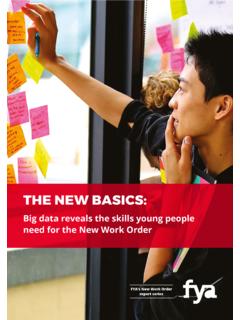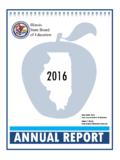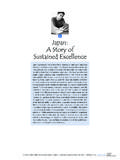Transcription of HOW YOUNG PEOPLE ARE FARING IN THE …
1 1 HOW YOUNG PEOPLE ARE FARING IN THE transition FROM school TO WORKHow YOUNG PEOPLE are FARING in the transition from school to and disclaimer The views and opinions expressed in this document are those of the author/project team and do not necessarily reflect the views of the Australian Government, state and territory materials presented in this report are for information purposes only. The information is provided solely on the basis that readers will be responsible for making their own assessments of the matters discussed and are advised to verify all relevant representations, statements and information and obtain independent advice before acting on any information contained in or in connection with this report.
2 While every effort has been made to ensure that the information is accurate the Foundation for YOUNG Australians and the National Centre for Vocational Education Research will not accept any liability for any loss or damage which may be incurred by any person acting in reliance upon the by:John Stanwick, Tham Lu, Toni Rittie and Michelle Circelli of the National Centre for Vocational Education Research (NCVER) 25 September 2014 The Foundation for YOUNG Australians (FYA) is the only national independent non-profit organisation dedicated to all YOUNG PEOPLE in Australia. Delivering a range of initiatives (co)designed with YOUNG PEOPLE , together we deliver change across out more at 1 Foreword 3 Executive summary 4 How YOUNG PEOPLE are FARING in the transition to from school to work 6 > Section 1: Participation in education is increasing 7 > Section 2: Educational attainment is also increasing 10 > Section 3.
3 YOUNG PEOPLE are increasingly working in casual or part-time jobs, and less in full-time jobs 12 > Section 4: Transitions to work 16 Conclusion 18 References 19 Appendix Data sources 19 Tables and figures index 21 CONTENTSHow YOUNG PEOPLE are FARING in the transition from school to 3 FOREWORDOur YOUNG PEOPLE are a vital resource to our country.
4 At the Foundation for YOUNG Australians (FYA) we believe in an Australia in which all our citizens: can sustain our standard of living; improve our quality of life; protect and nurture our fragile environment; and be active and generous contributors to the global family. For this vision to be realized, we must prepare our YOUNG PEOPLE for constant and evolving economic, social, cultural and envirzonmental change in Australia and the region. YOUNG Australians will need to be confident, connected, enterprising, innovative, optimistic and generous. IS AUSTRALIA INVESTING IN ITS YOUNG PEOPLE ENOUGH? THIS REPORT SUGGESTS NO. In our 16th annual research release, formerly called How YOUNG PEOPLE Are FARING , we explore YOUNG PEOPLE s transition from school to work .
5 This year the report forms part of a collection of findings, called Unlimited Potential: a data and information resource on YOUNG Australians. This online resource provides information on demographics, future challenges, transition from school to work and how YOUNG PEOPLE are contributing to and leading change. Around 30% of YOUNG Australians in the labour force are unemployed or underemployed, the proportion of higher education graduates who have found full-time work after graduating is declining, and YOUNG PEOPLE are moving into full time work at an older the situation may sound critical and it is there is still hope. FYA believes there should be a national conversation between all the generations about the role of YOUNG PEOPLE in shaping Australia s future.
6 There are four priority areas for this conversation, including how we will: > Educate and equip YOUNG PEOPLE with enterprising skills > Invest in YOUNG Australian social and business entrepreneurship > Turbocharge YOUNG PEOPLE s connections with Asia > Back YOUNG PEOPLE to contribute and lead changeUnlimited Potential will help us start this national conversation and create a dynamic and forward-thinking set of national policies and initiatives that will build the confidence and capability of Australia s YOUNG PEOPLE so we can prepare them for a changing world. Now we need governments, businesses, YOUNG PEOPLE and the broader community to join in the conversation and help us find Owen AM CEOHow YOUNG PEOPLE are FARING in the transition from school to IN EDUCATION CONTINUES TO INCREASEO verall rates of full-time education continue to increase for YOUNG PEOPLE .
7 A little over three-quarters of 15-19 year olds were in full-time education in 2013 and a little over 30% of 20-24 year olds were in full-time education. When looking at rates by education sector the findings are more variable. Participation in school continues to increase for 15-17 year olds. In 2013, of 17 year olds were participating in full-time schooling with females participating at a higher rate than males ( vs ). In addition, school retention rates continue to increase with year 7/8 to year 12 retention rates increasing from in 2008 to in 2013. Retention rates are higher for females than for participation in public vocational education and training (VET) for YOUNG PEOPLE (particularly 15-19 year olds not at school ) has been declining.
8 For this age group, the rate dropped from in 2011 to in 2013. Part of the reason for this is that YOUNG PEOPLE are staying at school . Rates of participation in apprenticeships have also been declining for YOUNG PEOPLE , especially 15-19 year olds, and particularly non-trade apprenticeships. Having said this, participation in VET in school programs continues to increase from in 2007 to in 2012 for 15-19 year olds. Participation in higher education has been variable for YOUNG PEOPLE . It has increased only very marginally between 2012 and 2013 for 15-19 year olds but declined for 20-24 year olds (from in 2012 to in 2013).This report, part of the Foundation for YOUNG Australians website Unlimited potential: a data and information source on YOUNG Australians, describes YOUNG PEOPLE s transition from school to work .
9 It looks at key education and employment indicators, as well as transitions into the labour market. This executive summary is structured according to these key summaryEDUCATIONAL ATTAINMENT CONTINUES TO INCREASEIn concert with participation, rates of educational attainment continue to increase. In 2013 the rate of year 12 attainment was for 20-24 year olds. Non- school certificate III and above rates of attainment also continues to increase. In 2013 the rates were for 20-24 year olds and for 25-29 year olds. However for 25-29 year olds the rates of attainment for higher education qualifications has remained fairly steady in 2009 and in 2013.
10 Rates of attainment vary considerably by sub-group of population. Rates of attainment for females are higher than for males for year 12, certificate III or above, and higher education qualifications. Year 12 rates of attainment are lower though for Indigenous YOUNG PEOPLE and YOUNG PEOPLE living in remote or very remote areas. According to the 2011 census, year 12 rates of attainment were for Indigenous 20-24 year olds and for 20-24 year olds living in remote/very remote areas. This compares to for all 20-24 year olds. However year 12 rates of attainment have increased for Indigenous YOUNG PEOPLE since the 2006 census (by percentage points as compared to percentage points for all 20-24 year olds).









